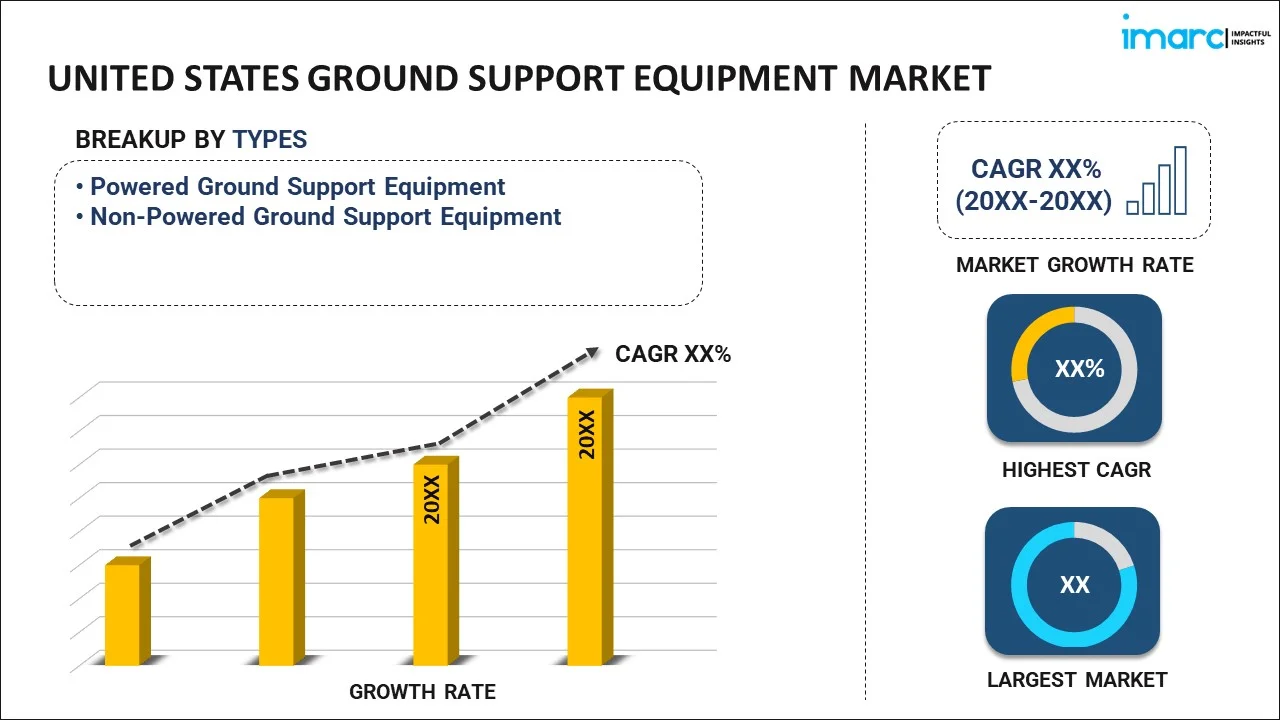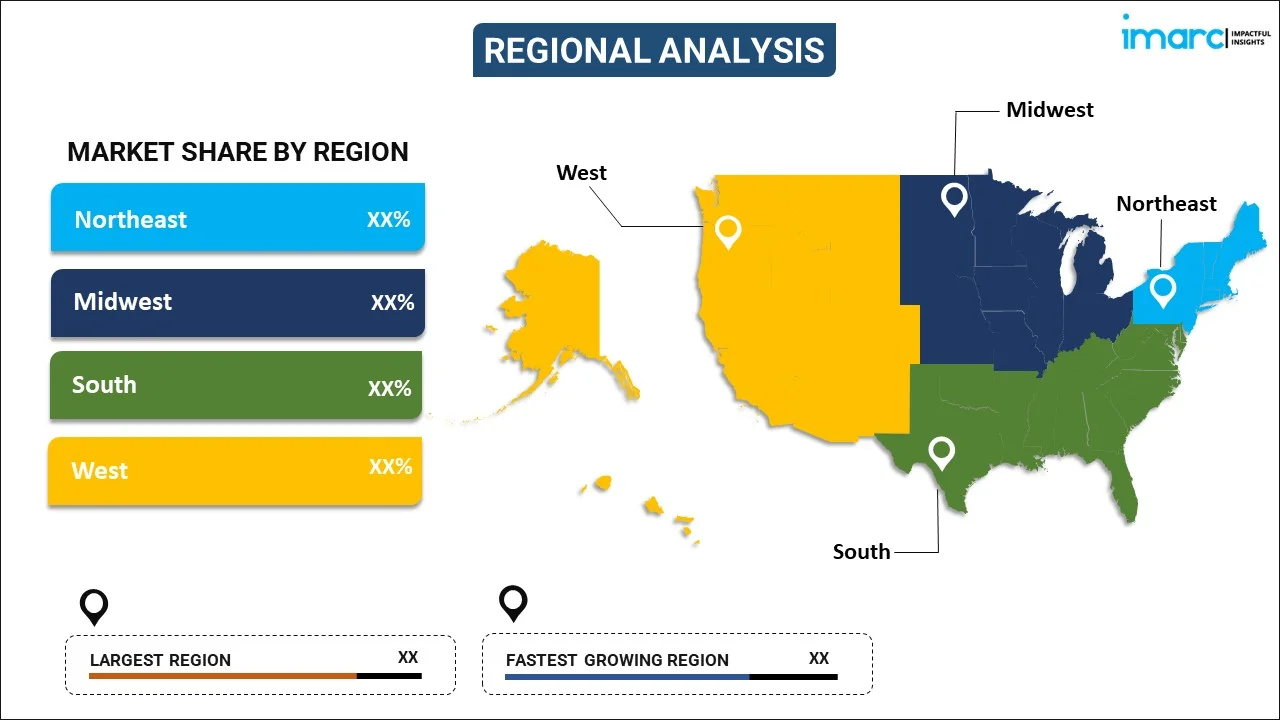
United States Ground Support Equipment Market Report by Type (Powered Ground Support Equipment, Non-Powered Ground Support Equipment), Power Source (Electric, Non-Electric, Hybrid), Application (Aircraft Handling, Passenger Handling, Cargo Handling), and Region 2025-2033
Market Overview:
United States ground support equipment market size reached USD 4.2 Billion in 2024. Looking forward, IMARC Group expects the market to reach USD 8.2 Billion by 2033, exhibiting a growth rate (CAGR) of 7.8% during 2025-2033. The rising growth in air travel and increasing air traffic, which necessitate the expansion of airport infrastructure and the acquisition of additional ground support equipment to handle the higher number of flights and passengers, is driving the market.
|
Report Attribute
|
Key Statistics
|
|---|---|
|
Base Year
|
2024 |
|
Forecast Years
|
2025-2033
|
|
Historical Years
|
2019-2024
|
| Market Size in 2024 | USD 4.2 Billion |
| Market Forecast in 2033 | USD 8.2 Billion |
| Market Growth Rate (2025-2033) | 7.8% |
United States Ground Support Equipment Market Analysis:
- Major Market Drivers: Increase in air passenger and cargo traffic, combined with federal investments in airport infrastructure modernization, are fueling need for energy-efficient, environmentally friendly ground support equipment among leading airports, propelling United States ground support equipment market demand.
- Key Market Trends: Electrification, automation, and IoT-based fleet management systems are revolutionizing U.S. ground handling operations with improvements in energy efficiency, real-time monitoring, and predictive maintenance capabilities in the United States ground support equipment market.
- Competitive Landscape: The market is defined by a combination of incumbent players and emerging innovators providing electric and hybrid GSE solutions, advanced telemetry integration, and customized equipment specifically meeting the requirements of particular airport operations.
- Challenges and Opportunities: Challenges are in terms of high upfront costs and infrastructure constraints for electric GSE. Opportunities are in government incentives, increasing sustainability mandates, and the continued pressure to accelerate airport digitalization and operational efficiency.
Ground support equipment (GSE) refers to a diverse array of tools, vehicles, and machinery essential for the maintenance, servicing, and operation of aircraft on the ground. This equipment plays a pivotal role in ensuring the safety, functionality, and efficiency of aviation operations. GSE includes a wide range of items such as aircraft tugs, tow tractors, ground power units, air conditioning units, maintenance stands, and more. These tools are specifically designed to meet the unique requirements of different aircraft types and support various ground activities, including aircraft pushback, refueling, power supply, and maintenance tasks. GSE is crucial for facilitating rapid turnaround times between flights, minimizing downtime, and ensuring that aircraft are ready for departure with optimal performance. In summary, GSE is an indispensable component of aviation infrastructure, contributing to the smooth and safe functioning of aircraft operations while they are on the ground.
United States Ground Support Equipment Market Trends:
Electrification of Ground Support Equipment
Ground support equipment (GSE) electrification is becoming a leading trend in the United States aviation industry, fueled by increasing focus on decarbonization and environmental regulation compliance. Airports are investing more in electric cargo loaders, baggage tugs, and aircraft tow tractors to cut emissions, decrease fuel reliance, and enhance operational effectiveness. This change is supported by the existence of incentives and funds from federal and state initiatives for encouraging sustainable airport operation. The higher energy efficiency decreased noise levels, and less maintenance requirements of electric GSE are promoting quick adoption. Also, the innovation of advanced battery systems with longer life cycles and quicker charging times is driving the transition faster. This change is redefining operational dynamics and enabling long-term sustainability objectives. These advancements mirror the growing United States ground support equipment market share because electrification takes center stage in forthcoming ground handling operations in major U.S. airports.
Integration of Telemetry and Fleet Management Systems
The inclusion of telemetry and fleet management systems into the ground support equipment is transforming the way airports track and manage assets in real time. These technologies enable operators to monitor vehicle location, performance parameters, fuel usage, and maintenance schedules from afar, facilitating data-driven decision-making that maximizes productivity and minimizes downtime. Adoption of IoT sensors and cloud-based analytics software is in full swing across airports of all sizes, promoting a transition from reactive to predictive maintenance. As per the sources, in January 2025, Oshkosh AeroTech introduced next-generation ground support solutions in Las Vegas including autonomous vehicles, sustainable technologies, and its iOPS fleet management system for smart airport operations. Moreover, the systems also support resource optimization by matching fleet size to actual usage patterns. With operational transparency as a new performance measure, the use of smart technologies is poised to grow exponentially. The digital revolution highlights the changing picture reflected in the United States ground support equipment market analysis, where technological efficiencies will drive procurement, and lifecycle plans for ground operations across the country.
Growing Need for Airport Modernization
Airport modernization projects in the United States are creating greater demand for sophisticated ground support equipment. With increases in passenger traffic, cargo loads, and flight movements, airports are also investing in high-performing, dependable, and scalable GSE to enhance turnaround times and reduce ground delays. Terminal upgrades and expansion projects routinely involve airside equipment upgrades with an emphasis on automation, safety features, and multi-operations capability. This is supported by federal infrastructure initiatives and regional development plans to improve aviation capacity. Consequently, GSE procurement is being highly tied to long-term planning and operational forecasting. As airport infrastructure grows, so does dependence on specialized equipment capable of addressing changing airside needs. These trends reflect the ongoing United States ground support equipment market growth, as modernization efforts serve as a key driver in redefining GSE investment plans and deployment standards across the country.
United States Ground Support Equipment Market Segmentation:
IMARC Group provides an analysis of the key trends in each segment of the market, along with forecasts at the country level for 2025-2033. Our report has categorized the market based on type, power source, and application.
Type Insights:

To get more information on this market, Request Sample
- Powered Ground Support Equipment
- Non-Powered Ground Support Equipment
The report has provided a detailed breakup and analysis of the market based on the type. This includes powered ground support equipment and non-powered ground support equipment.
Power Source Insights:
- Electric
- Non-Electric
- Hybrid
A detailed breakup and analysis of the market based on the power source have also been provided in the report. This includes electric, non-electric, and hybrid.
Application Insights:
- Aircraft Handling
- Passenger Handling
- Cargo Handling
The report has provided a detailed breakup and analysis of the market based on the application. This includes aircraft handling, passenger handling, and cargo handling.
Regional Insights:

- Northeast
- Midwest
- South
- West
The report has also provided a comprehensive analysis of all the major regional markets, which include the Northeast, Midwest, South, and West.
Competitive Landscape:
The market research report has also provided a comprehensive analysis of the competitive landscape in the market. Competitive analysis such as market structure, key player positioning, top winning strategies, competitive dashboard, and company evaluation quadrant has been covered in the report. Also, detailed profiles of all major companies have been provided.
Latest News and Developments:
- In May 2025, Global Ground Support introduced the GTV-5000 Glycol Transfer Vehicle in the United States. Developed to enhance deicing operations, the GTV-5000 increases fluid transfer efficiency, minimizes downtime, and aids environmental initiatives through real-time monitoring, heavy-duty storage, and hassle-free compatibility with all commercial deicers.
- In January 2025, Mallaghan opened North America's first all-electric refrigerated aircraft catering truck, the CT6000E, at Boston Logan Airport. Designed in partnership with International Motors, the zero-emission truck boosts safety and efficiency through CAS, 360° cameras, and telemetry, enabling sustainable aviation ground operations in the United States.
United States Ground Support Equipment Market Report Coverage:
| Report Features | Details |
|---|---|
| Base Year of the Analysis | 2024 |
| Historical Period | 2019-2024 |
| Forecast Period | 2025-2033 |
| Units | Billion USD |
| Scope of the Report | Exploration of Historical and Forecast Trends, Industry Catalysts and Challenges, Segment-Wise Historical and Predictive Market Assessment:
|
| Types Covered | Powered Ground Support Equipment, Non-Powered Ground Support Equipment |
| Power Sources Covered | Electric, Non-Electric, Hybrid |
| Applications Covered | Aircraft Handling, Passenger Handling, Cargo Handling |
| Regions Covered | Northeast, Midwest, South, West |
| Customization Scope | 10% Free Customization |
| Post-Sale Analyst Support | 10-12 Weeks |
| Delivery Format | PDF and Excel through Email (We can also provide the editable version of the report in PPT/Word format on special request) |
Key Benefits for Stakeholders:
- IMARC’s industry report offers a comprehensive quantitative analysis of various market segments, historical and current market trends, market forecasts, and dynamics of the United States ground support equipment market from 2019-2033.
- The research report provides the latest information on the market drivers, challenges, and opportunities in the United States ground support equipment market.
- Porter's five forces analysis assist stakeholders in assessing the impact of new entrants, competitive rivalry, supplier power, buyer power, and the threat of substitution. It helps stakeholders to analyze the level of competition within the United States ground support equipment industry and its attractiveness.
- A competitive landscape allows stakeholders to understand their competitive environment and provides an insight into the current positions of key players in the market.
Key Questions Answered in This Report
The ground support equipment market in the United States was valued at USD 4.2 Billion in 2024.
The United States ground support equipment market is projected to exhibit a (CAGR) of 7.8% during 2025-2033, reaching a value of USD 8.2 Billion by 2033.
The major drivers of the market are growing air traffic, airport expansion initiatives, the need for operational efficiency, and an aggressive move towards electrification and sustainability. Government funding for infrastructure and the use of smart technologies also complement growth in commercial, cargo, and regional airport segments.
Need more help?
- Speak to our experienced analysts for insights on the current market scenarios.
- Include additional segments and countries to customize the report as per your requirement.
- Gain an unparalleled competitive advantage in your domain by understanding how to utilize the report and positively impacting your operations and revenue.
- For further assistance, please connect with our analysts.
 Request Customization
Request Customization
 Speak to an Analyst
Speak to an Analyst
 Request Brochure
Request Brochure
 Inquire Before Buying
Inquire Before Buying




.webp)




.webp)












